The Impact of Population Growth on Natural Resources and Farmers’ Capacity to Adapt to Climate Change in Low-Income Countries
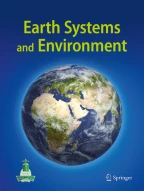
Population growth and natural resources are intricately linked and play role in climate disruption and farmers’ ability to adapt to climate change especially in developing countries with rapid demographic changes and economies mostly dependent on natural resources. Although literature exists on population issues, emphasis was given to positive roles of population growth providing only incomplete picture for stakeholders and policy makers. This constrained climate change adaptation and mitigation strategies, improving food security and attaining sustainable development goals. We reviewed publications on low-income countries with emphasis on sub-Saharan Africa and Southeast Asia. This review will bring forth often sidelined issue of population growth for decision-makers and future research in the context of achieving sustainable development goals of the United Nations for 2015–2030. Therefore, this review was initiated to reveal the impacts of population growth on natural resources and to uncover farmers’ capacity to adapt to climate change in low-income countries. Rapid population growth continues to be a major underlying force of environmental degradation and a threat to sustainable use of natural resources. It reduces the quality and quantity of natural resources through overexploitation, intensive farming and land fragmentation. Regions with high population pressure face scarcity of arable land, which leads to shortened/removed fallow period, declining soil fertility and farm income due to farm subdivision. Furthermore, landless individuals or those who operate small farms resettle or cultivate marginal lands, encroach on natural forests in search of more vacant land, which alters carbon source sink dynamics of the environment. Low farm income from small farms not only exacerbates food insecurity of farmers but also constrains their ability to adopt certain climate change adaptation technologies. All stakeholders should take swift actions to address challenges of rapid population growth and alter the dynamics between population, natural resources and climate change and its adaptation.
This is a preview of subscription content, log in via an institution to check access.
Access this article
Subscribe and save
Springer+ Basic
€32.70 /Month
- Get 10 units per month
- Download Article/Chapter or eBook
- 1 Unit = 1 Article or 1 Chapter
- Cancel anytime
Buy Now
Price includes VAT (France)
Instant access to the full article PDF.
Rent this article via DeepDyve
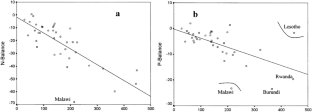
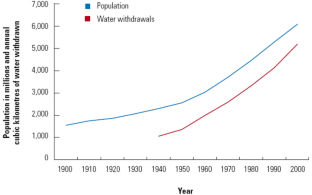
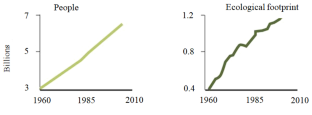
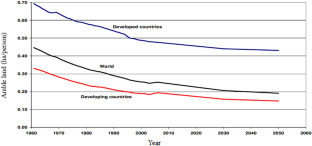
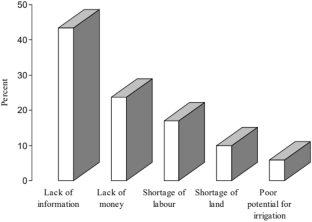
Similar content being viewed by others

Socio-economic and Eco-biological Dimensions in Resource Use and Conservation: Epilogue
Chapter © 2020

Climate Change and Land Use in the WANA Region with a Specific Reference to Morocco
Chapter © 2013

Climate Variability and Impact on Livelihoods in the Cold Arid Qinghai–Tibet Plateau
Chapter © 2018
References
- Abdul-Razak M, Kruse S (2017) The adaptive capacity of smallholder farmers to climate change in the Northern Region of Ghana. Clim Risk Manag 17:104–122 ArticleGoogle Scholar
- Acemoglu D, Fergusson L, Johnson S (2020) Population and conflict. Rev Econ Stud 87:1565–1604 ArticleGoogle Scholar
- Adamopoulos T, Restuccia D (2014) The size distribution of farms and international productivity differences. Am Econ Rev 104(6):1667–1697 ArticleGoogle Scholar
- Ahrends A, Burgess ND, Milledge SA, Bulling MT, Fisher B, Smart JC, Lewis SL (2010) Predictable waves of sequential forest degradation and biodiversity loss spreading from an African city. Proc Natl Acad Sci 107:14556–14561 ArticleGoogle Scholar
- Aizen MA, Aguiar S, Biesmeijer JC, Garibaldi LA, Inouye DW, Jung C, Pauw A (2019) Global agricultural productivity is threatened by increasing pollinator dependence without a parallel increase in crop diversification. Glob Change Biol 25:3516–3527 ArticleGoogle Scholar
- Albert JS, Destouni G, Duke-Sylvester SM, Magurran AE, Oberdorff T, Reis RE, Ripple WJ (2020) Scientists’ warning to humanity on the freshwater biodiversity crisis. Ambio 2021 50:85–94
- Alemu GT, Berhanie Ayele Z, Abelieneh Berhanu A (2017) Effects of land fragmentation on productivity in Northwestern Ethiopia. Adva Agric
- Ali A, Erenstein O (2017) Assessing farmer use of climate change adaptation practices and impacts on food security and poverty in Pakistan. Clim Risk Manag 16:183–194 ArticleGoogle Scholar
- Almer C, Laurent-Lucchetti J, Oechslin M (2017) Water scarcity and rioting: Disaggregated evidence from Sub-Saharan Africa. J Environ Econ Manag 86:193–209 ArticleGoogle Scholar
- Althor G, Watson JE, Fuller RA (2016) Global mismatch between greenhouse gas emissions and the burden of climate change. Sci Rep 6:20281 ArticleGoogle Scholar
- Amsalu A, De Graaff J (2007) Determinants of adoption and continued use of stone terraces for soil and water conservation in an Ethiopian highland watershed. Ecol Econ 61:294–302 ArticleGoogle Scholar
- Andersson JA (1999) The politics of land scarcity: land disputes in Save Communal Area, Zimbabwe. J S Afr Stud 25:553–578 ArticleGoogle Scholar
- Antwi-Agyei P, Stringer LC, Dougill AJ (2014) Livelihood adaptations to climate variability: insights from farming households in Ghana. Reg Environ Change 14:1615–1626 ArticleGoogle Scholar
- Antwi-Agyei P, Dougill AJ, Stringer LC (2015) Barriers to climate change adaptation: Evidence from northeast Ghana in the context of a systematic literature review. Clim Dev 7:297–309 ArticleGoogle Scholar
- Arsiso BK, Tsidu GM, Stoffberg GH, Tadesse T (2017) Climate change and population growth impacts on surface water supply and demand of Addis Ababa, Ethiopia. Clim Risk Manag 18:21–33 ArticleGoogle Scholar
- Aye GC, Edoja PE (2017) Effect of economic growth on CO2 emission in developing countries: Evidence from a dynamic panel threshold model. Cogent EconFinance 5:1379239 ArticleGoogle Scholar
- Banerjee S, Walder F, Büchi L, Meyer M, Held AY, Gattinger A, Van Der Heijden MG (2019) Agricultural intensification reduces microbial network complexity and the abundance of keystone taxa in roots. ISME J 13:1722–1736 ArticleGoogle Scholar
- Barbier EB, Hochard JP (2018) Poverty, rural population distribution and climate change. Environ Dev Econ 23:234–256 ArticleGoogle Scholar
- Bedasa NA, Hussein JW (2018) Challenges in Managing Land-Related Conflicts in East Hararghe Zone of Oromia Regional State, Ethiopia. Soc Nat Resour 31:351–366 ArticleGoogle Scholar
- Belay A, Recha JW, Woldeamanuel T, Morton JF (2017) Smallholder farmers’ adaptation to climate change and determinants of their adaptation decisions in the Central Rift Valley of Ethiopia. AgricFood Secur 6:24 ArticleGoogle Scholar
- Bezu S, Holden S (2014) Are rural youth in Ethiopia abandoning agriculture? World Dev 64:259–272 ArticleGoogle Scholar
- Bizimana C, Nieuwoudt WL, Ferrer SR (2004) Farm size, land fragmentation and economic efficiency in southern Rwanda. Agrekon 43:244–262 ArticleGoogle Scholar
- Blanco-Canqui H (2013) Crop residue removal for bioenergy reduces soil carbon pools: how can we offset carbon losses? Bioenergy Res 6:358–371 ArticleGoogle Scholar
- Bongaarts J, Casterline J (2013) Fertility transition: is sub-Saharan Africa different? Popul Dev Rev 38:153–168 ArticleGoogle Scholar
- Bongaarts J, O’Neill BC (2018) Global warming policy: Is population left out in the cold? Science 361:650–652 ArticleGoogle Scholar
- Bonsch M, Popp A, Biewald A, Rolinski S, Schmitz C, Weindl I, Dietrich JP (2015) Environmental flow provision: Implications for agricultural water and land-use at the global scale. Glob Environ Change 30:113–132 ArticleGoogle Scholar
- Brandt M, Rasmussen K, Peñuelas J, Tian F, Schurgers G, Verger A, Fensholt R (2017) Human population growth offsets climate-driven increase in woody vegetation in sub-Saharan Africa. Nat Ecol Evol 1:1–6 ArticleGoogle Scholar
- Brink AB, Eva HD (2009) Monitoring 25 years of land cover change dynamics in Africa: A sample based remote sensing approach. Appl Geogr 29:501–512 ArticleGoogle Scholar
- Brockerhoff EG, Barbaro L, Castagneyrol B et al (2017) Forest biodiversity, ecosystem functioning and the provision of ecosystem services. Biodivers Conserv 26:3005–3035 ArticleGoogle Scholar
- Brown ME, Funk C, Pedreros D, Korecha D, Lemma M, Rowland J, Verdin J (2017) A climate trend analysis of Ethiopia: examining subseasonal climate impacts on crops and pasture conditions. Clim Change 142:169–182 ArticleGoogle Scholar
- Bruinsma J (2009) The resource outlook to 2050: by how much do land, water and crop yields need to increase by 2050. In: Expert meeting on how to feed the world, pp. 24–26
- Bryan E, Deressa TT, Gbetibouo GA, Ringler C (2009) Adaptation to climate change in Ethiopia and South Africa: Options and constraints. Environ Sci Policy 12:413–426 ArticleGoogle Scholar
- Bryan E, Ringler C, Okoba B, Roncoli C, Silvestri S, Herrero M (2013) Adapting agriculture to climate change in Kenya: Household strategies and determinants. J Environ Manag 114:26–35 ArticleGoogle Scholar
- Bryant L, Carver L, Butler CD, Anage A (2009) Climate change and family planning: least-developed countries define the agenda. Bull World Health Organ 87:852–857 ArticleGoogle Scholar
- Castellanos-Navarrete A, Tittonell P, Rufino MC, Giller KE (2015) Feeding, crop residue and manure management for integrated soil fertility management—a case study from Kenya. Agric Syst 134:24–35 ArticleGoogle Scholar
- Chamberlin J, Jayne TS, Headey D (2014) Scarcity amidst abundance?Reassessing the potential for cropland expansion in Africa. Food Policy 48:51–65 ArticleGoogle Scholar
- Chen G, Li X, Liu X, Chen Y, Liang X, Leng J, Huang K (2020) Global projections of future urban land expansion under shared socioeconomic pathways. Nat Commun 11:1–12 Google Scholar
- Chidumayo EN, Gumbo DJ (2013) The environmental impacts of charcoal production in tropical ecosystems of the world: a synthesis. EnergySustain Dev 17:86–94 Google Scholar
- Cohen JE (2010) Population and climate change. Proc Am Philos Soc 154:158–182 Google Scholar
- Cramb RA, Garcia JNM, Gerrits RV, Saguiguit GC (1999) Smallholder adoption of soil conservation technologies: evidence from upland projects in the Philippines. Land Degrad Dev 10:405–423 ArticleGoogle Scholar
- Crist E, Mora C, Engelman R (2017) The interaction of human population, food production, and biodiversity protection. Science 356:260–264 ArticleGoogle Scholar
- d’Amour CB, Reitsma F, Baiocchi G, Barthel S, Güneralp B, Erb KH, Seto KC (2017) Future urban land expansion and implications for global croplands. Proc Natl Acad Sci 114(34):8939–8944 ArticleGoogle Scholar
- Dang HL, Li E, Nuberg I, Bruwer J (2019) Factors influencing the adaptation of farmers in response to climate change: a review. Clim Dev 11:765–774 ArticleGoogle Scholar
- de Vries FT, Thébault E, Liiri M, Birkhofer K, Tsiafouli MA, Bjørnlund L, Bardgett RD (2013) Soil food web properties explain ecosystem services across European land use systems. Proc Natl Acad Sci 110:14296–14301 ArticleGoogle Scholar
- DeFries RS, Rudel T, Uriarte M, Hansen M (2010) Deforestation driven by urban population growth and agricultural trade in the twenty-first century. Nat Geosci 3:178–181 ArticleGoogle Scholar
- deGraaff MA, Hornslein N, Throop HL, Kardol P, van Diepen LT (2019) Effects of agricultural intensification on soil biodiversity and implications for ecosystem functioning: a meta-analysis. Adv Agron 155:1–44 ArticleGoogle Scholar
- Dejen E, Anteneh W, Vijverberg J (2017) The decline of the Lake Tana (Ethiopia) fisheries: causes and possible solutions. Land Degrad Dev 28:1842–1851 ArticleGoogle Scholar
- Deressa TT, Hassan RM, Ringler C, Alemu T, Yesuf M (2009) Determinants of farmers’ choice of adaptation methods to climate change in the Nile Basin of Ethiopia. Glob Environ Change 19:248–255 ArticleGoogle Scholar
- DESA U (2019) World population prospects 2019: highlights. United Nations Department for Economic and Social Affairs Google Scholar
- D’Odorico P, Davis KF, Rosa L, Carr JA, Chiarelli D, Dell’Angelo J et al (2018) The global food-energy-water nexus. Rev Geophys 56:456–531
- Dodson JC, Dérer P, Cafaro P, Götmark F (2020) Population growth and climate change: addressing the overlooked threat multiplier. Sci Total Environ 748:141346 ArticleGoogle Scholar
- Döös BR (2002) Population growth and loss of arable land. Glob Environ Chang 12:303–311 ArticleGoogle Scholar
- Drechsel P, Kunze D, De Vries FP (2001) Soil nutrient depletion and population growth in sub-Saharan Africa: a Malthusian nexus? Popul Environ 22:411–423 ArticleGoogle Scholar
- Duncan AJ, Bachewe F, Mekonnen K, Valbuena D, Rachier G, Lule D, Erenstein O (2016) Crop residue allocation to livestock feed, soil improvement and other uses along a productivity gradient in Eastern Africa. Agr Ecosyst Environ 228:101–110 ArticleGoogle Scholar
- Ehrlich PR, Parnell DR, Silbowitz A (1971) The population bomb, vol 68. Ballantine Books Google Scholar
- Evans SG, Ge S, Voss CI, Molotch NP (2018) The role of frozen soil in groundwater discharge predictions for warming alpine watersheds. Water Resour Res 54:1599–1615 ArticleGoogle Scholar
- Fadina AMR, Barjolle D (2018) Farmers’ adaptation strategies to climate change and their implications in the Zou department of South Benin. Environments 5:15 ArticleGoogle Scholar
- FAO (2010) Global forest resources assessment: progress towards sustainable forest management. FAO Google Scholar
- Foley JA, DeFries R, Asner GP, Barford C, Bonan G, Carpenter SR, Helkowski JH (2005) Global consequences of land use. Science 309:570–574 ArticleGoogle Scholar
- Foley JA, Ramankutty N, Brauman KA, Cassidy ES, Gerber JS, Johnston M, Balzer C (2011) Solutions for a cultivated planet. Nature 478:337–342 ArticleGoogle Scholar
- Ford JD, Berrang-Ford L, Bunce A, McKay C, Irwin M, Pearce T (2015) The status of climate change adaptation in Africa and Asia. Reg Environ Change 15:801–814 ArticleGoogle Scholar
- Froese R, Schilling J (2019) The nexus of climate change, land use, and conflicts. Curr Clim Change Rep 5:24–35 ArticleGoogle Scholar
- Gebere SB, Alamirew T, Merkel BJ, Melesse AM (2016) Land use and land cover change impact on groundwater recharge: the case of lake haramaya watershed, Ethiopia. In: Melesse A, Abitew W (eds) Landscape dynamics, soils and hydrological processes in varied climates. Springer, Cham, pp 93–110
- Gebremedhin B, Swinton SM (2003) Investment in soil conservation in northern Ethiopia: the role of land tenure security and public programs. Agric Econ 29:69–84 ArticleGoogle Scholar
- Geissler S, Hagauer D, Horst A, Krause M, Sutcliffe P (2013) Biomass energy strategy Ethiopia. AMBERO Consult GesellschaftmbH Immanuel-Kant-Str 41:61476 Google Scholar
- Gezie A, Assefa WW, Getnet B, Anteneh W, Dejen E, Mereta ST (2018) Potential impacts of water hyacinth invasion and management on water quality and human health in Lake Tana watershed, Northwest Ethiopia. Biol Invasions 20:2517–2534 ArticleGoogle Scholar
- Gill RJ, Baldock KC, Brown MJ, Cresswell JE, Dicks LV, Fountain MT, Ollerton J (2016) Protecting an ecosystem service: approaches to understanding and mitigating threats to wild insect pollinators. Adv Ecol Res 54:135–206 ArticleGoogle Scholar
- Gleeson T, VanderSteen J, Sophocleous MA, Taniguchi M, Alley WM, Allen DM, Zhou Y (2010) Groundwater sustainability strategies. Nat Geosci 3:378–379 ArticleGoogle Scholar
- Gliessman SR (2014) Agroecology: the ecology of sustainable food systems. CRC Press BookGoogle Scholar
- Godfray HCJ, Beddington JR, Crute IR, Haddad L, Lawrence D, Muir JF et al (2010) Food security: the challenge of feeding 9 billion people. Science 327:812–818 ArticleGoogle Scholar
- Gomiero T (2016) Soil degradation, land scarcity and food security: Reviewing a complex challenge. Sustainability 8(3):281 ArticleGoogle Scholar
- Grassini P, Eskridge KM, Cassman KG (2013) Distinguishing between yield advances and yield plateaus in historical crop production trends. Nat Commun 4:2918 ArticleGoogle Scholar
- Güneralp B, Lwasa S, Masundire H, Parnell S, Seto KC (2017) Urbanization in Africa: challenges and opportunities for conservation. Environ Res Lett 13(1):015002 ArticleGoogle Scholar
- Headey DD, Jayne TS (2014) Adaptation to land constraints: Is Africa different? Food Policy 48:18–33 ArticleGoogle Scholar
- United Nations, Department of Economic and Social Affairs, Population Division (2019) World Population Prospects 2019: Highlights (ST/ESA/SER.A/423)
- Huang CW, McDonald RI, Seto KC (2018) The importance of land governance for biodiversity conservation in an era of global urban expansion. Landsc Urban Plan 173:44–50 ArticleGoogle Scholar
- Hütsch BW, Schubert S (2018) Maize harvest index and water use efficiency can be improved by inhibition of gibberellin biosynthesis. J Agron Crop Sci 204:209–218 ArticleGoogle Scholar
- Jha S, Bawa KS (2006) Population growth, human development, and deforestation in biodiversity hotspots. Conserv Biol 20:906–912 ArticleGoogle Scholar
- Jiang L, Hardee K (2011) How do recent population trends matter to climate change? Popul Res Policy Rev 30:287–312 ArticleGoogle Scholar
- Jinji N (2006) International trade and terrestrial open-access renewable resources in a small open economy. Can J Econ/Revue canadienne d’économique 39(3):790–808 ArticleGoogle Scholar
- Jones DL, Cross P, Withers PJ, DeLuca TH, Robinson DA, Quilliam RS, Edwards-Jones G (2013) Nutrient stripping: the global disparity between food security and soil nutrient stocks. J Appl Ecol 50:851–862 ArticleGoogle Scholar
- Josephson AL, Ricker-Gilbert J, Florax RJ (2014) How does population density influence agricultural intensification and productivity? Evidence from Ethiopia. Food Policy 48:142–152 ArticleGoogle Scholar
- Kah HK (2017) ‘Boko Haram is losing, but so is food production’: conflict and food insecurity in Nigeria and Cameroon. Afr Dev 42:177–196 Google Scholar
- Kastner T, Erb KH, Haberl H (2014) Rapid growth in agricultural trade: effects on global area efficiency and the role of management. Environ Res Lett 9(3):034015 ArticleGoogle Scholar
- Kehoe L, Romero-Muñoz A, Polaina E, Estes L, Kreft H, Kuemmerle T (2017) Biodiversity at risk under future cropland expansion and intensification. Nat Ecol Evol 1:1129–1135 ArticleGoogle Scholar
- Khan MN, Mohammad F (2014) Eutrophication: challenges and solutions. In: Ansari A, Gill S (eds) Eutrophication: causes, consequences and control. Springer, Dordrecht pp 1–15
- Kopittke PM, Menzies NW, Wang P, McKenna BA, Lombi E (2019) Soil and the intensification of agriculture for global food security. Environ Int 132:105078 ArticleGoogle Scholar
- Lal R (2004) Soil carbon sequestration impacts on global climate change and food security. Science 304:1623–1627 ArticleGoogle Scholar
- Latruffe L, Piet L (2014) Does land fragmentation affect farm performance? A case study from Brittany, France. Agric Syst 129:68–80 ArticleGoogle Scholar
- Laurance WF, Sayer J, Cassman KG (2014) Agricultural expansion and its impacts on tropical nature. Trends Ecol Evol 29:107–116 ArticleGoogle Scholar
- Leichenko R, Silva JA (2014) Climate change and poverty: vulnerability, impacts, and alleviation strategies. Wiley Interdiscipl Rev Clim Change 5:539–556 ArticleGoogle Scholar
- Li X, Panke-Buisse K, Yao X, Coleman-Derr D, Ding C, Wang X, Ruan H (2020) Peanut plant growth was altered by monocropping-associated microbial enrichment of rhizospheremicrobiome. Plant Soil 446:655–669 ArticleGoogle Scholar
- Liao H, Cao HS (2013) How does carbon dioxide emission change with the economic development? Statistical experiences from 132 countries. Glob Environ Change 23:1073–1082 ArticleGoogle Scholar
- Liverpool-Tasie LSO, Omonona BT, Sanou A, Ogunleye WO (2017) Is increasing inorganic fertilizer use for maize production in SSA a profitable proposition? Evidence from Nigeria. Food Policy 67:41–51 ArticleGoogle Scholar
- Liyanage CP, Yamada K (2017) Impact of population growth on the water quality of natural water bodies. Sustainability 9:1405 ArticleGoogle Scholar
- López-Carr D, Burgdorfer J (2013) Deforestation drivers: population, migration, and tropical land use. Environ Sci Policy Sustain Dev 55:3–11 ArticleGoogle Scholar
- Maguza-Tembo F, Mangison J, Edris AK, Kenamu E (2017) Determinants of adoption of multiple climate change adaptation strategies in Southern Malawi: an ordered probit analysis. J Dev Agric Econ 9:1–7 ArticleGoogle Scholar
- McCann JC (1997) The plow and the forest: narratives of deforestation in Ethiopia, 1840–1992. Environ Hist 2:138–159 ArticleGoogle Scholar
- Mekuriaw A, Heinimann A, Zeleke G, Hurni H (2018) Factors influencing the adoption of physical soil and water conservation practices in the Ethiopian Highlands. Int Soil Water Conserv Res 6:23–30 ArticleGoogle Scholar
- Mertz O, Ravnborg HM, Lövei GL, Nielsen I, Konijnendijk CC (2007) Ecosystem services and biodiversity in developing countries. Biodivers Conserv 16:2729–2737 ArticleGoogle Scholar
- Molotoks A, Stehfest E, Doelman J, Albanito F, Fitton N, Dawson TP, Smith P (2018) Global projections of future cropland expansion to 2050 and direct impacts on biodiversity and carbon storage. Glob Change Biol 24:5895–5908 ArticleGoogle Scholar
- Mueller ND, Gerber JS, Johnston M, Ray DK, Ramankutty N et al (2012) Closing yield gaps: nutrient and water management to boost crop production. Nature 490:254–257 ArticleGoogle Scholar
- Mugizi FM, Matsumoto T (2020) Population pressure and soil quality in Sub-Saharan Africa: Panel evidence from Kenya. Land Use Policy 94:104499 ArticleGoogle Scholar
- Mugizi FM, Matsumoto T (2021) A curse or a blessing? Population pressure and soil quality in Sub-Saharan Africa: Evidence from rural Uganda. Ecol Econ 179:106851 ArticleGoogle Scholar
- Murtaugh PA, Schlax MG (2009) Reproduction and the carbon legacies of individuals. Glob Environl Change 19:14–20 ArticleGoogle Scholar
- Nagayets, O. (2005). Small farms: current status and key trends. The future of small farms, 355
- Nguyen TM, Bressac C, Chevrier C (2013) Heat stress affects male reproduction in a parasitoid wasp. J Insect Physiol 59:248–254 ArticleGoogle Scholar
- Ngwira S, Watanabe T (2019) An analysis of the causes of deforestation in Malawi: a case of Mwazisi. Land 8(3):48 ArticleGoogle Scholar
- Niroula GS, Thapa GB (2005) Impacts and causes of land fragmentation, and lessons learned from land consolidation in South Asia. Land use policy 22:358–372 ArticleGoogle Scholar
- Noack F, Larsen A (2019) The contrasting effects of farm size on farm incomes and food production. Environ Res Lett 14(8):084024 ArticleGoogle Scholar
- Okello C, Tomasello B, Greggio N, Wambiji N, Antonellini M (2015) Impact of population growth and climate change on the freshwater resources of Lamu Island, Kenya. Water 7:1264–1290 ArticleGoogle Scholar
- Olivier JG, Schure KM, Peters JAHW (2017) Trends in global CO2 and total greenhouse gas emissions. PBL Netherlands Environmental Assessment Agency, p 5 Google Scholar
- Ordway EM, Asner GP, Lambin EF (2017) Deforestation risk due to commodity crop expansion in sub-Saharan Africa. Environ Res Lett 12(4):044015 ArticleGoogle Scholar
- Osman KT (2018) Management of soil problems. Springer BookGoogle Scholar
- Oyetunji PO, Ibitoye OS, Akinyemi GO, Fadele OA, Oyediji OT (2020) The Effects of Population Growth on Deforestation in Nigeria: 1991–2016. J Appl Sci Environ Manag 24:1329–1334 Google Scholar
- Paul M, waGĩthĩnji M (2017) Small farms, smaller plots: land size, fragmentation, and productivity in Ethiopia. J Peasant Stud 45:757–775 ArticleGoogle Scholar
- Pearson TR, Brown S, Murray L, Sidman G (2017) Greenhouse gas emissions from tropical forest degradation: an underestimated source. Carbon Balance Manag 12:3 ArticleGoogle Scholar
- Perrings C, Halkos G (2015) Agriculture and the threat to biodiversity in sub-saharan Africa. Environ Res Lett 10:095015 ArticleGoogle Scholar
- Plusquellec H (2009) Modernization of large-scale irrigation systems: Is it an achievable objective or a lost cause. Irrig Drain 58:104–120 ArticleGoogle Scholar
- Rahman S, Rahman M (2009) Impact of land fragmentation and resource ownership on productivity and efficiency: The case of rice producers in Bangladesh. Land Use Policy 26:95–103 ArticleGoogle Scholar
- Rapsomanikis G (2015) The economic lives of smallholder farmers: An analysis based on household data from nine countries. Food and Agriculture Organization of the United Nations Google Scholar
- Ray DK, Mueller ND, West PC, Foley JA (2013) Yield trends are insufficient to double global crop production by 2050. PLoS ONE 8:e66428 ArticleGoogle Scholar
- Reardon T, Vosti SA (1995) Links between rural poverty and the environment in developing countries: asset categories and investment poverty. World Dev 23:1495–1506 ArticleGoogle Scholar
- Reddy SRC, Chakravarty SP (1999) Forest dependence and income distribution in a subsistence economy: evidence from India. World Dev 27:1141–1149 ArticleGoogle Scholar
- Rudel TK (2013) The national determinants of deforestation in sub-Saharan Africa. Philos Trans R Soc Lond B Biol Sci 368(1625):20120405 ArticleGoogle Scholar
- Sanchez PA, Shepherd KD, Soule MJ, Place FM, Buresh RJ, Izac AMN, Woomer PL (1997) Soil fertility replenishment in Africa: an investment in natural resource capital. Repl Soil Fertil Afr 51:1–46 Google Scholar
- Seto KC, Güneralp B, Hutyra LR (2012) Global forecasts of urban expansion to 2030 and direct impacts on biodiversity and carbon pools. Proc Natl Acad Sci 109:16083–16088 ArticleGoogle Scholar
- Smith P, Gregory PJ, Van Vuuren D, Obersteiner M, Havlík P, Rounsevell M, Bellarby J (2010) Competition for land. Philos Trans R Soc Lond B Biol Sci 365:2941–2957 ArticleGoogle Scholar
- Smith P, House JI, Bustamante M, Sobocká J, Harper R, Pan G, andPaustian, K. (2016) Global change pressures on soils from land use and management. Glob Change Biol 22:1008–1028 ArticleGoogle Scholar
- Snyder H (2019) Literature review as a research methodology: An overview and guidelines. J Bus Res 104:333–339 ArticleGoogle Scholar
- Stephenson J, Newman K, Mayhew S (2010) Population dynamics and climate change: what are the links? J Public Health 32:150–156 ArticleGoogle Scholar
- Surya B, Syafri S, Sahban H, Sakti HH (2020) Natural Resource conservation based on community economic empowerment: perspectives on watershed management and slum settlements in Makassar City, South Sulawesi. Indonesia Land 9(4):104 Google Scholar
- Tilman D, Balzer C, Hill J, Befort BL (2011) Global food demand and the sustainable intensification of agriculture. Proc Natl Acad Sci 108:20260–20264 ArticleGoogle Scholar
- Tole L (1998) Sources of deforestation in tropical developing countries. Environ Manag 22:19–33 ArticleGoogle Scholar
- Toth G, Szigeti C (2016) The historical ecological footprint: From over-population to over-consumption. Ecol Ind 60:283–291 ArticleGoogle Scholar
- Tran TQ, Van Vu H (2019) Land fragmentation and household income: First evidence from rural Vietnam. Land Use Policy 89:104247 ArticleGoogle Scholar
- Tritsch I, Le Tourneau FM (2016) Population densities and deforestation in the Brazilian Amazon: New insights on the current human settlement patterns. Appl Geogr 76:163–172 ArticleGoogle Scholar
- Trivedi P, Delgado-Baquerizo M, Anderson IC, Singh BK (2016) Response of soil properties and microbial communities to agriculture: implications for primary productivity and soil health indicators. Front Plant Sci 7:990 ArticleGoogle Scholar
- Tscharntke T, Clough Y, Wanger TC, Jackson L, Motzke I, Perfecto I, Whitbread A (2012) Global food security, biodiversity conservation and the future of agricultural intensification. Biol Cons 151:53–59 ArticleGoogle Scholar
- United Nations Educational Scientific and Cultural Organization (UNESCO) (2003) Water for People, Water for Life: The United Nations World Water Development Report
- Urdal H (2008) Population, resources, and political violence: A subnational study of India, 1956–2002. J Conflict Resolut 52:590–617 ArticleGoogle Scholar
- Van Ittersum MK, Van Bussel LG, Wolf J, Grassini P, Van Wart J, Guilpart N, Yang H (2016) Can sub-Saharan Africa feed itself? Proc Natl Acad Sci 113:14964–14969 ArticleGoogle Scholar
- Vanlauwe B, Six J, Sanginga N, Adesina AA (2015) Soil fertility decline at the base of rural poverty in sub-Saharan Africa. Nat Plants 1:1–1 ArticleGoogle Scholar
- Verma P, Raghubanshi AS (2019) Rural development and land use land cover change in a rapidly developing agrarian South Asian landscape. Remote Sens ApplSoc Environ 14:138–147 Google Scholar
- Vesco P, Dasgupta S, De Cian E, Carraro C (2020) Natural resources and conflict: A meta-analysis of the empirical literature. Ecol Econ 172:106633 ArticleGoogle Scholar
- Walie SD (2015) Perception of farmers toward physical soil and water conservation structures in Wyebla Watershed, Northwest Ethiopia. Acad J Plant Sci 7:34–40 Google Scholar
- Walsh BS, Parratt SR, Hoffmann AA, Atkinson D, Snook RR, Bretman A, Price TA (2019) The impact of climate change on fertility. Trends Ecol Evol 34:249–259 ArticleGoogle Scholar
- Wetzel WC, Kharouba HM, Robinson M, Holyoak M, andKarban, R. (2016) Variability in plant nutrients reduces insect herbivore performance. Nature 539:425–427 ArticleGoogle Scholar
- Win ZC, Mizoue N, Ota T, Kajisa T, Yoshida S (2018) Consumption rates and use patterns of firewood and charcoal in urban and rural communities in Yedashe Township. Myanmar For 9:429 Google Scholar
- Wong G, Greenhalgh T, Westhorp G, Buckingham J, Pawson R (2013) RAMESES publication standards: Meta-narrative reviews. J Adv Nurs 69(5):987–1004 ArticleGoogle Scholar
- WWF (2018) Living planet report-2018. In: Grooten M, Almond REA (eds) Aiming higher. WWF Google Scholar
- Yadav DS, Sood P, Sharma LK, Sharma K (2018) Smart farming secures livelihood: a case study of small farm from Himachal Pradesh. Int J Farm Sci 8:94–99 ArticleGoogle Scholar
- Yonas B, Beyene F, Negatu L, Abdeta A (2013) Influence of resettlement on pastoral land use and local livelihoods in southwest Ethiopia. Trop Subtrop Agroecosyst 16(1):103–117 Google Scholar
- Zegeye H (2017) Major drivers and consequences of deforestation in Ethiopia: implications for forest conservation. Asian J Sci Technol 8:5166–5175 Google Scholar
- Zhao ZH, Hui C, He DH, Li BL (2015) Effects of agricultural intensification on ability of natural enemies to control aphids. Sci Rep 5:8024 ArticleGoogle Scholar
- Zilverberg C, Kreuter U, Conner R (2009) Population growth and fertilizer use: ecological and economic consequences in Santa Cruz del Quiché, Guatemala. Soc Nat Resour 23:1–13 ArticleGoogle Scholar
Author information
Authors and Affiliations
- School of Natural Resource Management and Environmental Sciences, College of Agriculture and Environmental Sciences, Haramaya University, Haramaya, Ethiopia Mengistu M. Maja & Samuel F. Ayano
- Mengistu M. Maja






